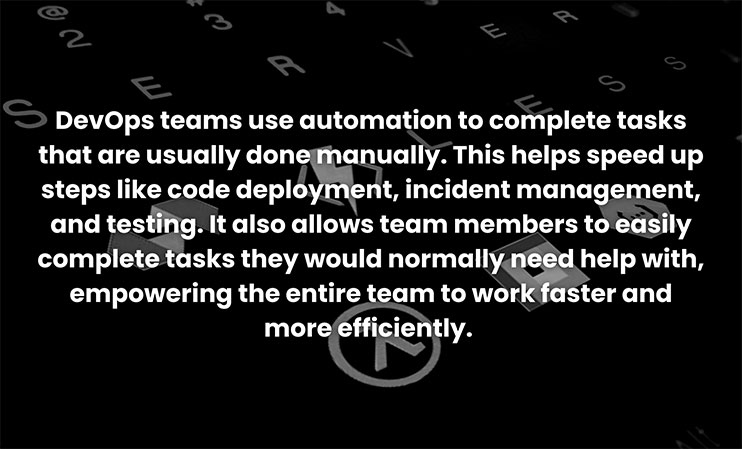You may have heard of other teams using DevOps to quickly build and deploy digital products. But just what is DevOps, and is it really that much better than other development workflows? Here’s a handy introduction to just what DevOps entails, how it works, and the benefits it provides.
What is DevOps?
DevOps is the perfect marriage of development and IT operations—hence the Dev (development) and Ops (IT operations). Like Agile and Lean, it’s a methodology for more effective project management and team member coordination, but unlike other methodologies, it’s specifically focused on facilitating collaboration between developers and IT teams.
In addition to making collaboration easier, the goals of DevOps are to speed up development and deployment, boost security, and ultimately improve product quality. It achieves this by keeping both teams (development and IT) in open communication at each stage of the project, and by using shorter cycles to quickly build, collect feedback, and improve.
Since we mentioned Agile and Lean, it’s worth stating that DevOps is not meant to replace other methodologies. Instead, it can be combined with these methodologies to optimize the work process.
How does DevOps work?
DevOps uses a combination of tools, best practices, and philosophies to speed up and improve the project lifecycle. For one thing, the development and IT operations teams are combined into a single unit, with all team members remaining active in the project throughout. As a result, team members often develop multidisciplinary skills beyond their initial role.
Sometimes, quality assurance and security are also integrated with the DevOps team. Technically, this is called a DevSecOps, but it’s often just added under the DevOps umbrella.
DevOps teams use automation to complete tasks that are usually done manually. This helps speed up steps like code deployment, incident management, and testing. It also allows team members to easily complete tasks they would normally need help with, empowering the entire team to work faster and more efficiently.
DevOps follows six key practices:
- Planning
- Building
- Continuous integration and delivery
- Monitoring
- Operating
- Continuous feedback
But while it’s tempting to think of each of these practices as steps in a linear process, it’s more accurate to envision them as an intertwining loop or infinity circle: each step relates to the others and gets repeated over and over again throughout the project lifecycle.
Continuous integration and delivery
In continuous integration and delivery, the code is located in a central repository, and all changes are integrated into the repository instead of being built and tested separately. Automated builds and tests allow you to detect issues early on and minimize the time needed for product release. Since new features and changes roll out quickly, you can collect feedback sooner and start improving the product sooner.

Why use DevOps?
DevOps isn’t just a methodology for getting better products out faster; it’s a way to continuously improve and maintain software or applications. In today’s world, most digital products aren’t simply a one-and-done thing, and DevOps provides the perfect model to keep evolving and expediting your products for consumers or your own internal team. Besides allowing you to better serve your customers or support your team, DevOps increases your advantage in a highly competitive market.
What are the benefits of using DevOps?
DevOps provides the following benefits:
- Increased speed
- Smoother collaboration
- Faster deployment
- Better reliability
- Stronger security
- Ability to scale
Increased speed
DevOps teams use automation and continuous delivery to speed up the development process. After launch, the same tools allow them to make updates and resolve issues more quickly than via traditional methods.
Smoother collaboration
DevOps is built on the idea of close collaboration. By giving shared responsibilities to developers and IT teams instead of siloing each in its own department, DevOps keeps everyone on the same page and cuts out unnecessary steps like handoffs and reporting back.
Faster deployment
With continuous delivery, code is always ready to deploy. There are no code freezes or integration and testing phases. New changes are made frequently and quickly, rather than over the course of a long-term project. By building and deploying in short cycles, you can quickly launch, update, and problem-solve.
Better reliability
In a DevOps model, team members are heavily involved in every stage of the process, and this integration, coupled with continuous delivery, allows you to deliver a more reliable product to your end-users.
Stronger security
Automation and configuration allow you to move quickly without sacrificing security. And through continuous integration and delivery, security gets built into every step of the DevOps process.
Ability to scale
DevOps team members use automation and integration to work on more than just one stage of a project, which makes it easier to scale up or down at any time.
Is DevOps the right approach for you?
DevOps is a great way to efficiently build competitive products. A strong DevOps strategy can help you roll out applications more quickly than using traditional methodologies, and it can improve the quality, reliability, and security of your product in the long run—giving you a clear competitive edge. While it may be an adjustment at first, most teams end up loving DevOps and wondering how they ever managed without it.
Need help creating a DevOps team? We’re happy to provide you with developers, IT professionals, DevOps managers, and more. Get started on your project now with a free consultation.

